Intrigue and the sinking of a Monster
The Tirpitz Story began well before it was even built. We all know that Germany lost the First World War – Well they Didn’t !
In fact there was no formal surrender; there was an Armistice which really meant that both sides simply stopped fighting. However, in order to achieve the Armistice, Germany had to pay huge sums of money (it was finally paid in 2008) plus give up all its armaments such as Artillery, Airplanes, Ships, Submarines and even hundreds of thousands of Machine Guns.
Their capital ships (destroyers and above) were taken to Scapa Flow in Scotland with skeleton crews and six months later, at a given signal, were all scuttled. The German public were devastated. They were humiliated and starving until Hitler appeared on the scene in 1933 with his declared aim of righting the wrongs of the 1919 Armistice. His actions united the German population which made Hitler a hero in their eyes. He simply threw out the conditions of the First World War Armistice and started to rebuild the Army, the Luftwaffe and the Navy. No other country wanted to fight Germany again so he had free reign to do anything because he had the support of the German public.
He took over Alsace Lorraine which had been a French Territory and nobody stopped him. In 1936, among a lot of other projects, he gave orders to build 2 x Capital Ships which were way beyond the Tonnage Limits of the 1919 Armistice. One was the Bismarck and the other was The Tirpitz. Both were double in size, of what the Armistice allowed. In addition he ordered Submarines galore. His obvious intention was to starve Britain into a full Surrender by blocking supplies from across the Atlantic. With Hitler present the Tirpitz was launched on 1st April 1939 at Wilhelmshaven and the ship was fully commissioned in February 1941.

It had 8 x 15” Guns which were among the largest in the world and the ships armoured belt was made of 13” thick steel with its deck at 5” thick steel. It even had its own airplanes (Italian Arado Seaplanes) which were used as Spotter planes.
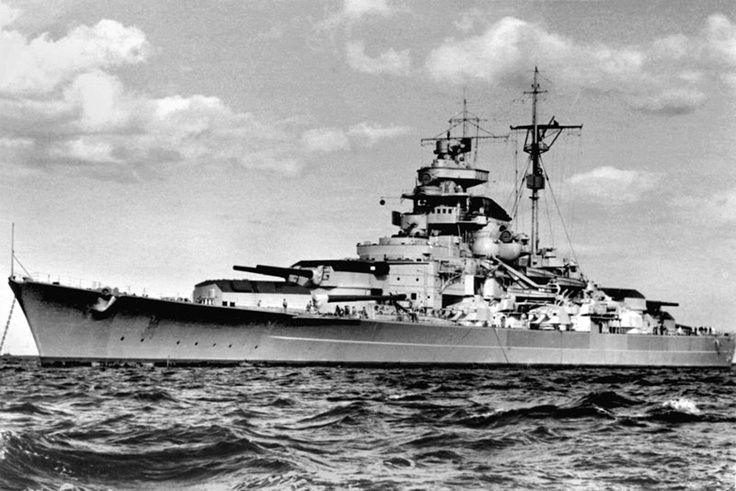
Britain already had similar ships, the largest and oldest was HMS Hood which with other Royal Navy ships hunted the Bismarck (twin ship to Tirpitz). During the engagement between HMS Hood and the Bismarck a lucky long range shell penetrated the Hood’s magazine and the blast was so big that the Hood was blown apart. Over 1400 British Sailors were killed when the Hood blew up in the Denmark Straits in May 1941. There were only three survivors.
This prompted Churchill to issue an immediate Order – “Sink the Bismarck”. During the attack a Swordfish Aircraft from HMS Ark Royal scored a torpedo hit on the stern of the Bismarck and this action jammed the Bismarck’s Rudder in one position. She could only steam in circles and could not get away. The British ships all closed in. Within the hour the Bismarck was sunk by gunfire and further torpedoes with the loss of 800 German Sailors.
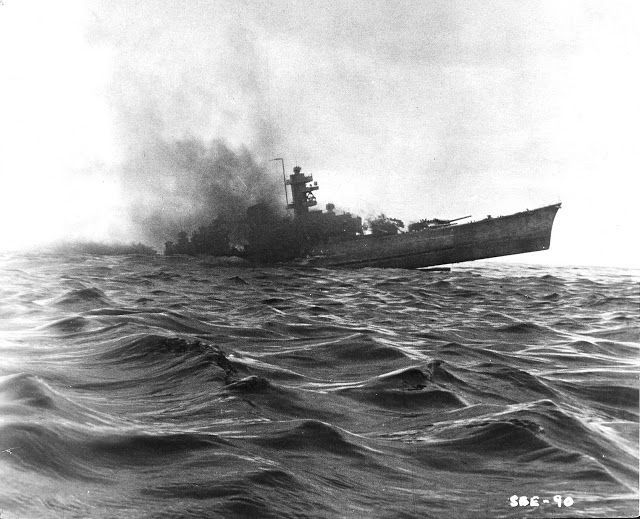
The British Ships rescued 111 German Seamen from drowning until a U-Boat was sighted and all the British Ships withdrew. The naval spotlight then centred on the Tirpitz which was a huge threat to British shipping, especially in the Atlantic. She was the only German Capital Ship still afloat. The ship was moved repeatedly from one Norwegian Fjord to another and was constantly harassed by British Bombers. The Tirpitz sheer presence was enough to keep Britain’s main Battle Fleet on standby in case the Tirpitz left Norway and entered the Atlantic Ocean. Scapa Flow was the nearest deep water base for British Ships. The other danger was that the Tirpitz could attack the Supply Convoys that Britain was sending to Russia. Either way strenuous efforts had to be made to keep the Tirpitz trapped in the Norwegian Fjords.
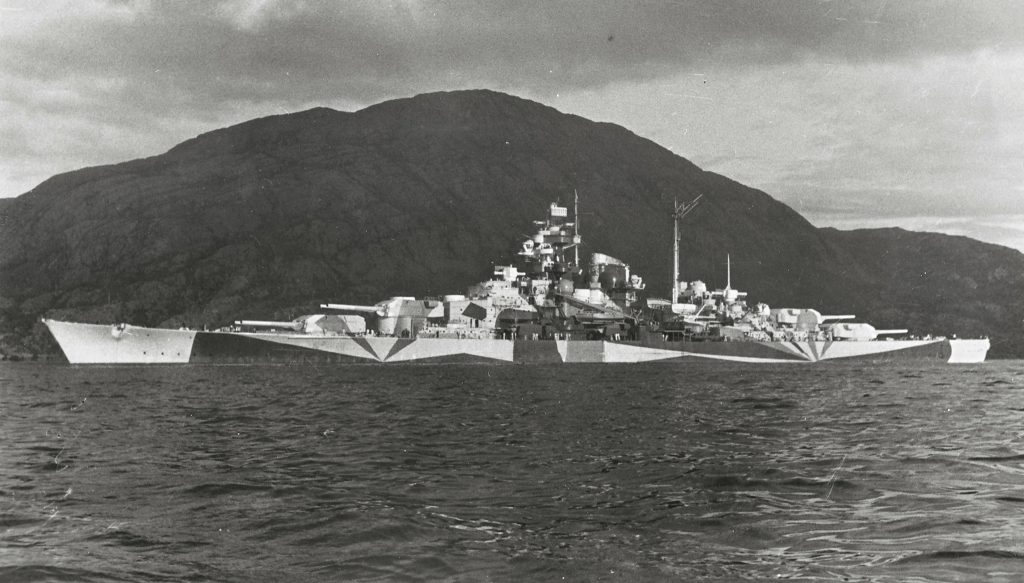
No less that 10 bombing attacks were made by the Royal Navy but none achieved serious damage to the Tirpitz. Then the British built a number of Midget Submarines each with a crew of 4 and trained them to cut a way through the anti-submarine nets guarding Tirpitz and if possible to explode bombs underneath the ship. These Midget Submarines had then to be towed across the North Sea. Six set off but two were lost during the tow. The Midgets were cast off within 50 miles of the base in Norway and they got into the Fjords without serious problems. Then disaster struck and two more were sunk by German gunfire. Two Midgets got through the anti-submarine nets and place their bombs under the keel of Tirpitz. Then the Midget’s crews were captured and were actually on the ship when the delayed timers on the bombs were activated and the blew a hole in the bottom of Tirpitz.
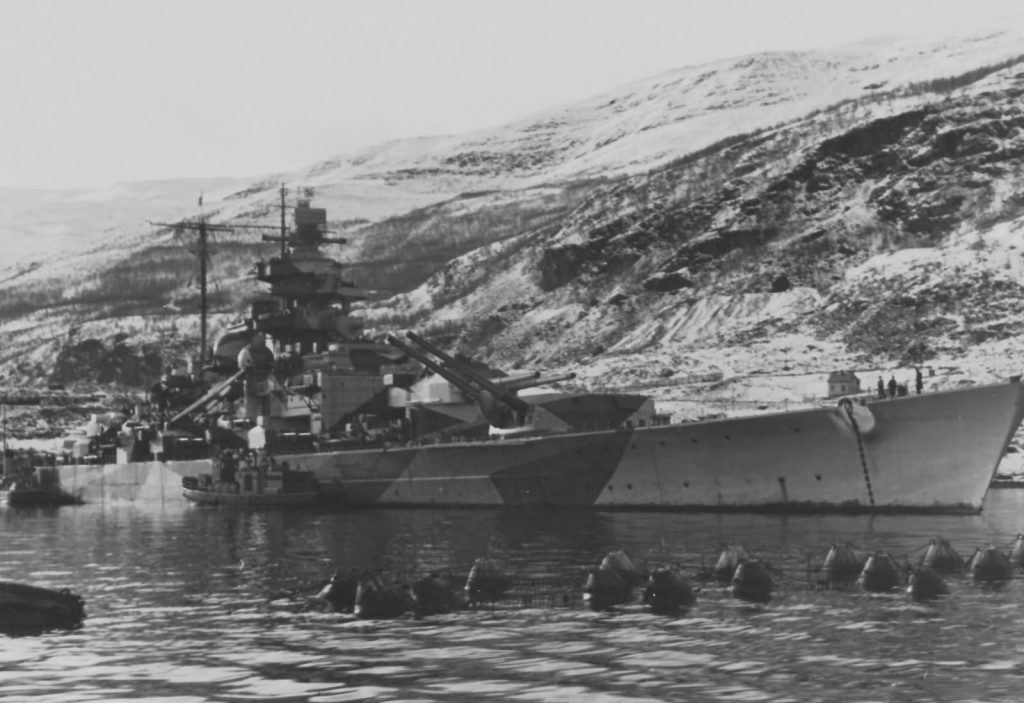
The British Government did not know that the ship was so badly damaged and therefore gave the job of sinking the Tirpitz to the RAF with its heavier bombloads. The German Captain thought that the ship was still a threat as a floating big gun platform because he knew that Tirpitz would simply sit on the bed of the fjord but he was wrong. Because of all the explosions underneath the ship, a huge hollow had been made in the ground underwater, causing the ship to list to port by 1*. This list was never corrected.
The RAF was given the task in 1944. Various bombing raids were made from Scotland but most failed mainly due to impossible weather conditions plus the heavy smokescreens that the Tirpitz employed. Then the Dambuster Squadron (617) plus No 9 Squadron, both the elite of the RAF, took over. Their first attack was foiled again by weather conditions but a few days later, on 12th November 1944, the weather improved.
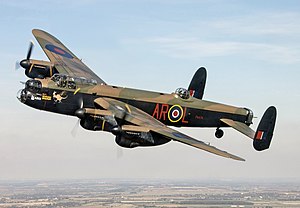
Using the new ‘Tallboy’ Bombs, invented by Barnes-Wallace, they dropped these bombs which reached supersonic speed, from 12,000ft. Although Tirpitz was heavily armoured with thick steel plating, the thinnest 5” plating was on the main deck. Three of the Tallboys struck the ship and went straight through a number of decks before exploding in a Boiler Room, all on the Port side. The resultant explosions lifted the whole ship 3 feet into the air, dropped it down again and this time the list increased by stages to 35*, then 65* and finally 135*.
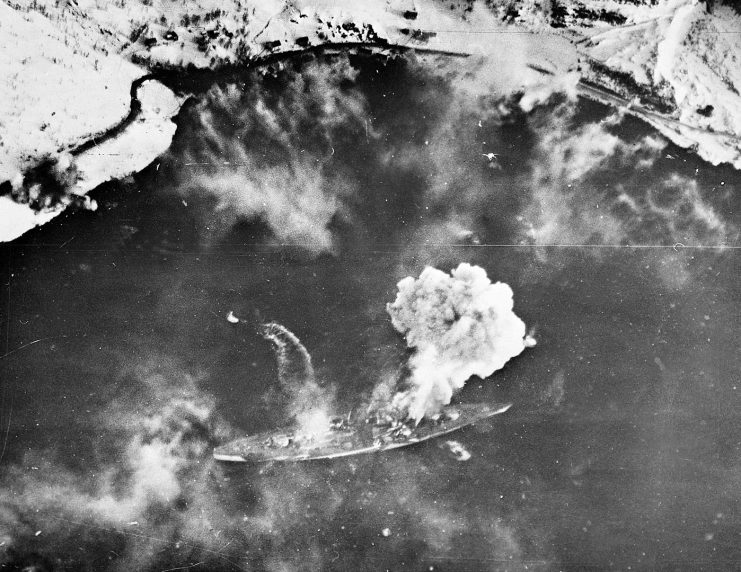
The hollow under the ship, caused by earlier bombing, meant that the Tirpitz sank to deck level, then rolled over and the superstructure stuck in the mud. Hundreds of German Sailors were trapped and urgent efforts were made to cut through the bottom of the ship to release them. However, the Oxy-Acetylene gear was not strong enough to cut through the heavy steel. The Germans tried to acquire stronger Gear from the local Norwegians but they had all been hidden. After around 4 hours they found they found heavier cutters and broke through, releasing 87 men. The remainder died of asphyxiation and just over 1,000 men perished as 17,000 tons of seawater entered the ship via the holes in her port side.
All the British aircraft returned safely to Scotland bar one which had been damaged by anti-aircraft fire. This pilot diverted to Sweden and although he found a military aerodrome, his outer starboard engine failed and he crash landed in a field. All the crew survived and were repatriated to Britain.
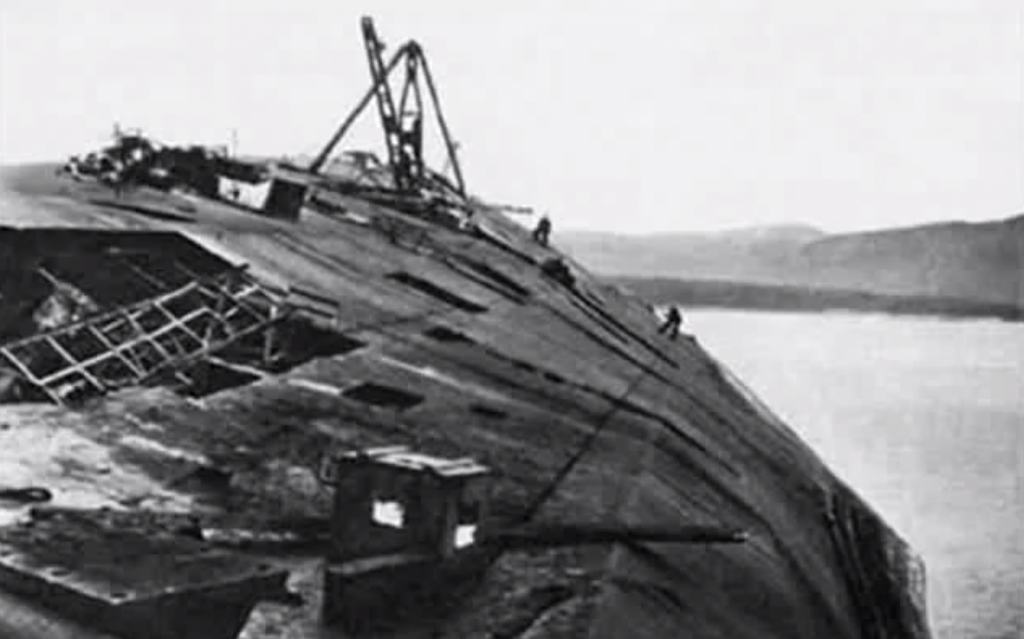
The Germans held an enquiry afterwards and the Fighter Controller, Major Ehrler, was held responsible for the lack of fighter cover along with various members of his Staff. The various delays were caused by the fact that the fighter pilots were largely untrained, having had to retreat ahead of the advancing Russians. Also an incoming aircraft had priority to land on the runway causing the fighters to wait for take-off.
The Tirpitz Captain was called Weber and it was he who called for fighter support from the nearest German aerodrome which was only 5 minutes flying time away. At that stage the Lancasters were approaching but the fighters were totally disorganised. His 38 fighters had arrived too late, the Lancasters had gone !
Ehler was convicted at a Court Marshall and sentenced to three years in prison but was released after just one month. He had left his Control Room in the charge of an NCO. Ehler was also demoted. Another enquiry ordered by Admiral Donitz concluded that the place chosen for Tirpitz to hide was inadequate and that communications with Ehler’s Operations Room were “chaotic”.
There has always been speculation that Ehler and/or some of his Staff were persuaded to delay the passing of the request for fighters to help the Tirpitz by British members of MI6 and some Germans were ‘spirited away’ from Norway afterwards.
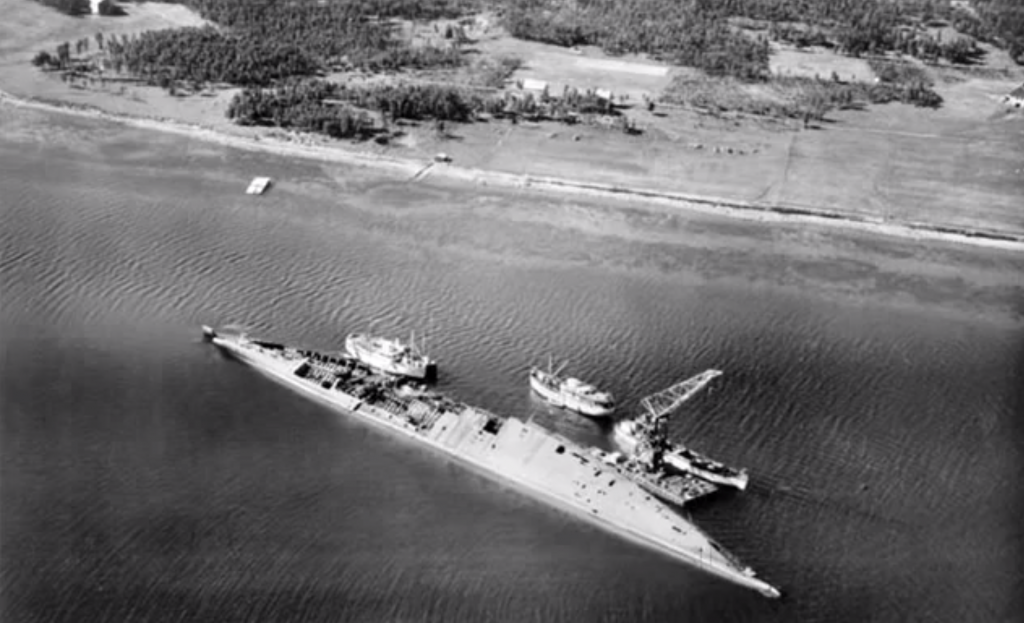
The Tirpitz was sunk and the British Capital Ships that were retained in Scapa Flow could then be released from their roles as ‘Guardians’ of Tirpitz and sent to the Far East to continue the war against Japan.
- Timing of the Attack
- 08:00 First Radar Warning
- 08:15 Second Warning of Lancasters
- 08:54 Air Raid Warning Sounded
- 09:15 18 Lancasters 75 miles away
- 09:20 Fighters second request
- 09:34 Heavy Anti-Aircraft Fire
- 09:38 29 Tallboy Bombs dropped from 12,000 ft, 3 Direct Hits, 7 close by all on Port side, Tirpitz listing moved from 35 degrees to 65 degrees
- 09:45 C Gun Turret exploded, list grew to 135 degrees. Ship capsized with the superstructure sitting on the bottom of the Fjord. 1,200 men lost as 17,000 tons of seawater entered the ship